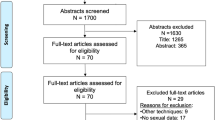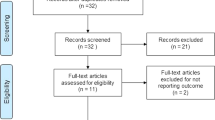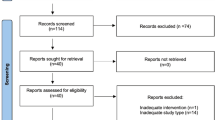Abstract
Background
Surgical treatments for lower urinary tract symptoms (LUTS) due to benign prostatic obstruction (BPO) are affected by potentially bothersome side effects on sexual, and, above all, ejaculatory function. Several minimally invasive techniques have been proposed in the last years in order to overcome these consequences. Our aim is to summarize and evaluate the efficacy on LUTS relieve and the impact on sexual/ejaculatory function of Rezum, prostate artery embolization (PAE), implantation of a prostatic urethral lift (PUL) and the temporary implantable nitinol device (TIND).
Methods
A systematic review of the English-language literature was conducted using the MEDLINE, Embase, and Web of Science databases from January 2000 to October 2022, according to the PRISMA guidelines (PROSPERO ID: CRD42023466515). Randomized controlled trials (RCTs), prospective studies and non-comparative or comparative studies assessing the impact on functional and ejaculatory function after minimally invasive surgical therapies for Male LUTS were evaluated. Risk of bias assessment was performed according to the Risk of Bias in Non-Randomized Studies of Interventions (ROBINS-I) tool for comparative studies, and the revised Cochrane risk-of-bias tool for randomized trials (RoB 2) for RCTs.
Results
Overall, 47 studies were included (n = 4 for TIND; n = 9 for Rezum; n = 13 for PUL; n = 21 for PAE). Most studies relied on prospective patient cohorts and were rated as low risk of bias. Across studies assessing the efficacy of Rezum, a significant improvement in terms of IPSS (ranging from −47% to −56%) and Qmax (ranging from +39% to +87%) was reported. On the other hand, according to IIEF-5 score, Rezum had a minimal impact on sexual function (ranging from −1% to −3%). PUL showed a positive impact on IPSS (ranging from −35% to −58.2%) and Qmax (ranging from +49.9% to +114.7%) and sexual function. Finally, PAE showed encouraging functional results with IPSS score reducing from −12.8% to 63.3% and Qmax improving from +8% to 114.9% but the available evidence regarding the potential impact of PAE on sexual outcomes were limited.
Conclusion
Rezum, PAE, PUL and TIND are safe and feasible techniques associated with a significant functional improvement. While available data suggest a minimal impact of Rezum and PUL on ejaculatory function, the evidence after PAE and TIND are still limited. Therefore, our review lays the foundation for further research aiming to identify the criteria to select best candidates for uMIST to tailor the management in light of specific patient- and disease- factors.
This is a preview of subscription content, access via your institution
Access options
Subscribe to this journal
Receive 4 print issues and online access
$259.00 per year
only $64.75 per issue
Buy this article
- Purchase on Springer Link
- Instant access to full article PDF
Prices may be subject to local taxes which are calculated during checkout



Similar content being viewed by others
References
Lim KB. Epidemiology of clinical benign prostatic hyperplasia. Asian J Urol. 2017;4:148–51.
Gravas S, Malde S, Cornu JN, Gacci M, Gratzke C, Herrmann TRW, et al. From BPH to male LUTS: a 20-year journey of the EAU guidelines. Prostate Cancer Prostatic Dis. 2023. https://doi.org/10.1038/S41391-023-00700-3.
Management of Non-neurogenic Male LUTS - DISEASE MANAGEMENT - Uroweb. 2003. https://uroweb.org/guidelines/management-of-non-neurogenic-male-luts/chapter/disease-management.
Manfredi C, García-Gómez B, Arcaniolo D, García-Rojo E, Crocerossa F, Autorino R, et al. Impact of surgery for benign prostatic hyperplasia on sexual function: a systematic review and meta-analysis of erectile function and ejaculatory function. Eur Urol Focus. 2022;8:1711–32.
Sessa F, Polverino P, Siena G, Bisegna C, Lo Re M, Spatafora P, et al. Transperineal Laser Ablation of the Prostate (TPLA) for lower urinary tract symptoms due to benign prostatic obstruction. J Clin Med. 2023;12. https://doi.org/10.3390/JCM12030793.
Checcucci E, Veccia A, De Cillis S, Piramide F, Volpi G, Amparore D, et al. New ultra-minimally invasive surgical treatment for benign prostatic hyperplasia: a systematic review and analysis of comparative outcomes. Eur Urol Open Sci. 2021;33:28–41.
Knoll T, Omar MI, Maclennan S, Hernández V, Canfield S, Yuan Y, et al. Key steps in conducting systematic reviews for underpinning clinical practice guidelines: methodology of the European Association of Urology. Eur Urol. 2018;73:290–300.
Page MJ, McKenzie JE, Bossuyt PM, Boutron I, Hoffmann TC, Mulrow CD, et al. The PRISMA 2020 statement: an updated guideline for reporting systematic reviews. BMJ. 2021;372. https://doi.org/10.1136/BMJ.N71.
Moons KGM, de Groot JAH, Bouwmeester W, Vergouwe Y, Mallett S, Altman DG, et al. Critical appraisal and data extraction for systematic reviews of prediction modelling studies: the CHARMS checklist. PLoS Med. 2014;11. https://doi.org/10.1371/JOURNAL.PMED.1001744.
Sterne JA, Hernán MA, Reeves BC, Savović J, Berkman ND, Viswanathan M, et al. ROBINS-I: a tool for assessing risk of bias in non-randomised studies of interventions. BMJ. 2016;355. https://doi.org/10.1136/BMJ.I4919.
Sterne JAC, Savović J, Page MJ, Elbers RG, Blencowe NS, Boutron I, et al. RoB 2: a revised tool for assessing risk of bias in randomised trials. BMJ. 2019;366. https://doi.org/10.1136/BMJ.L4898.
Bagla S, Smirniotopoulos JB, Orlando JC, Van Breda A, Vadlamudi V. Comparative analysis of prostate volume as a predictor of outcome in prostate artery embolization. J Vasc Inter Radio. 2015;26:1832–8.
Bilhim T, Pisco J, Campos Pinheiro L, Rio Tinto H, Fernandes L, Pereira JA, et al. Does polyvinyl alcohol particle size change the outcome of prostatic arterial embolization for benign prostatic hyperplasia? Results from a single-center randomized prospective study. J Vasc Inter Radio. 2013;24:1595–1602.e1.
Wang MQ, Guo LP, Zhang GD, Yuan K, Li K, Duan F, et al. Prostatic arterial embolization for the treatment of lower urinary tract symptoms due to large (> 80 mL) benign prostatic hyperplasia: results of midterm follow-up from Chinese population. BMC Urol. 2015;15. https://doi.org/10.1186/S12894-015-0026-5.
Wang M, Guo L, Duan F, Yuan K, Zhang G, Li K, et al. Prostatic arterial embolization for the treatment of lower urinary tract symptoms caused by benign prostatic hyperplasia: a comparative study of medium- and large-volume prostates. BJU Int. 2016;117:155–64.
Yu SCH, Cho CCM, Hung EHY, Zou J, Yuen BTY, Shi L, et al. Thickness-to-height ratio of intravesical prostatic protrusion predicts the clinical outcome and morbidity of prostatic artery embolization for benign prostatic hyperplasia. J Vasc Inter Radio. 2019;30:1807–16.
Moreira AM, de Assis AM, Carnevale FC, Oliveira DS, Antunes AA. Improvements in irritative versus obstructive symptoms of the international prostate symptom score after prostatic artery embolization in 174 patients, in a single center. Cardiovasc Interv Radio. 2020;43:613–9.
Salem R, Hairston J, Hohlastos E, Riaz A, Kallini J, Gabr A, et al. Prostate artery embolization for lower urinary tract symptoms secondary to benign prostatic hyperplasia: results from a prospective FDA-approved investigational device exemption study. Urology. 2018;120:205–10.
Russo GI, Kurbatov D, Sansalone S, Lepetukhin A, Dubsky S, Sitkin I, et al. Prostatic arterial embolization vs. open prostatectomy: a 1-year matched-pair analysis of functional outcomes and morbidities. Urology. 2015;86:343–8.
Gao YA, Huang Y, Zhang R, Yang YD, Zhang Q, Hou M, et al. Benign prostatic hyperplasia: prostatic arterial embolization versus transurethral resection of the prostate-a prospective, randomized, and controlled clinical trial. Radiology. 2014;270:920–8.
Carnevale FC, Moreira AM, Harward SH, Bhatia S, de Assis AM, Srougi M, et al. Recurrence of lower urinary tract symptoms following prostate artery embolization for benign hyperplasia: single center experience comparing two techniques. Cardiovasc Interv Radio. 2017;40:366–74.
Wang MQ, Wang Y, Yan JY, Yuan K, Zhang GD, Duan F, et al. Prostatic artery embolization for the treatment of symptomatic benign prostatic hyperplasia in men ≥75 years: a prospective single-center study. World J Urol. 2016;34:1275–83.
Bilhim T, Costa NV, Torres D, Pisco J, Carmo S, Oliveira AG. Randomized clinical trial of balloon occlusion versus conventional microcatheter prostatic artery embolization for benign prostatic hyperplasia. J Vasc Inter Radio. 2019;30:1798–806.
Wang MQ, Zhang JL, Xin HN, Yuan K, Yan J, Wang Y, et al. Comparison of clinical outcomes of prostatic artery embolization with 50-μm Plus 100-μm Polyvinyl Alcohol (PVA) particles versus 100-μm PVA particles alone: a prospective randomized trial. J Vasc Inter Radio. 2018;29:1694–702.
Pisco JM, Bilhim T, Costa NV, Torres D, Pisco J, Pinheiro LC, et al. Randomised clinical trial of prostatic artery embolisation versus a sham procedure for benign prostatic hyperplasia. Eur Urol. 2020;77:354–62.
Hacking N, Vigneswaran G, Maclean D, Modi S, Dyer J, Harris M, et al. Technical and imaging outcomes from the UK registry of prostate artery embolization (UK-ROPE) study: focusing on predictors of clinical success. Cardiovasc Interv Radio. 2019;42:666–76.
Carnevale FC, Iscaife A, Yoshinaga EM, Moreira AM, Antunes AA, Srougi M. Transurethral Resection of the Prostate (TURP) versus original and PErFecTED Prostate Artery Embolization (PAE) due to Benign Prostatic Hyperplasia (BPH): Preliminary results of a single center, prospective, urodynamic-controlled analysis. Cardiovasc Interv Radio. 2016;39:44–52.
Ray AF, Powell J, Speakman MJ, Longford NT, DasGupta R, Bryant T, et al. Efficacy and safety of prostate artery embolization for benign prostatic hyperplasia: an observational study and propensity-matched comparison with transurethral resection of the prostate (the UK-ROPE study). BJU Int. 2018;122:270–82.
Vigneswaran G, Maclean D, Hadi M, Maher B, Modi S, Bryant T, et al. Prostatic Artery Embolization (PAE) and Transurethral Resection of the Prostate (TURP) have a Differential Impact on Lower Urinary Tract Symptoms (LUTS): retrospective analysis of the multicentre UK-ROPE (UK Register of Prostate Embolization) study. Cardiovasc Interv Radio. 2021;44:1095–102.
Insausti I, Galbete A, Lucas-Cava V, de Ocáriz AS, Solchaga S, Monreal R, et al. Prostatic artery embolization (PAE) using polyethylene glycol microspheres: safety and efficacy in 81 patients. Cardiovasc Interv Radio. 2022;45:1339–48.
Insausti I, Sáez de Ocáriz A, Galbete A, Capdevila F, Solchaga S, Giral P, et al. Randomized comparison of prostatic artery embolization versus transurethral resection of the prostate for treatment of benign prostatic hyperplasia. J Vasc Inter Radio. 2020;31:882–90.
Abt D, Müllhaupt G, Hechelhammer L, Markart S, Güsewell S, Schmid HP, et al. Prostatic artery embolisation versus transurethral resection of the prostate for benign prostatic hyperplasia: 2-yr outcomes of a randomised, open-label, single-centre trial. Eur Urol. 2021;80:34–42.
Mcvary KT, Gange SN, Shore ND, Bolton DM, Cowan BE, Brown BT, et al. Treatment of LUTS secondary to BPH while preserving sexual function: randomized controlled study of prostatic urethral lift. J Sex Med. 2014;11:279–87.
Sønksen J, Barber NJ, Speakman MJ, Berges R, Wetterauer U, Greene D, et al. Prospective, randomized, multinational study of prostatic urethral lift versus transurethral resection of the prostate: 12-month results from the BPH6 study. Eur Urol. 2015;68:643–52.
Roehrborn CG, Gange SN, Shore ND, Giddens JL, Bolton DM, Cowan BE, et al. The prostatic urethral lift for the treatment of lower urinary tract symptoms associated with prostate enlargement due to benign prostatic hyperplasia: the L.I.F.T. study. J Urol. 2013;190:2161–7.
Eure G, Gange S, Walter P, Khan A, Chabert C, Mueller T, et al. Real-world evidence of prostatic urethral lift confirms pivotal clinical study results: 2-year outcomes of a retrospective multicenter study. J Endourol. 2019;33:576–84.
Rukstalis D, Rashid P, Bogache WK, Tutrone RF, Barkin J, Chin PT, et al. 24-month durability after crossover to the prostatic urethral lift from randomised, blinded sham. BJU Int. 2016;118:14–22.
Cantwell AL, Bogache WK, Richardson SF, Tutrone RF, Barkin J, Fagelson JE, et al. Multicentre prospective crossover study of the ‘prostatic urethral lift’ for the treatment of lower urinary tract symptoms secondary to benign prostatic hyperplasia. BJU Int. 2014;113:615–22.
Chin PT, Bolton DM, Jack G, Rashid P, Thavaseelan J, Yu RJ, et al. Prostatic urethral lift: two-year results after treatment for lower urinary tract symptoms secondary to benign prostatic hyperplasia. Urology. 2012;79:5–11.
Roehrborn CG, Rukstalis DB, Barkin J, Gange SN, Shore ND, Giddens JL, et al. Three year results of the prostatic urethral L.I.F.T. study. Can J Urol. 2015;22:7772–82.
Gratzke C, Barber N, Speakman MJ, Berges R, Wetterauer U, Greene D, et al. Prostatic urethral lift vs. transurethral resection of the prostate: 2-year results of the BPH6 prospective, multicentre, randomized study. BJU Int. 2017;119:767–75.
Sievert KD, Schonthaler M, Berges R, Toomey P, Drager D, Herlemann A, et al. Minimally invasive prostatic urethral lift (PUL) efficacious in TURP candidates: a multicenter German evaluation after 2 years. World J Urol. 2019;37:1353–60.
McNicholas TA, Woo HH, Chin PT, Bolton D, Fernández Arjona M, Sievert KD, et al. Minimally invasive prostatic urethral lift: surgical technique and multinational experience. Eur Urol. 2013;64:292–9.
Porpiglia F, Fiori C, Amparore D, Kadner G, Manit A, Valerio M, et al. Second-generation of temporary implantable nitinol device for the relief of lower urinary tract symptoms due to benign prostatic hyperplasia: results of a prospective, multicentre study at 1 year of follow-up. BJU Int. 2019;123:1061–9.
Kadner G, Valerio M, Giannakis I, Manit A, Lumen N, Ho BSH, et al. Second generation of temporary implantable nitinol device (iTind) in men with LUTS: 2 year results of the MT-02-study. World J Urol. 2020;38:3235–44.
Rukstalis D, Grier D, Stroup SP, Tutrone R, deSouza E, Freedman S, et al. Prostatic Urethral Lift (PUL) for obstructive median lobes: 12 month results of the MedLift Study. Prostate Cancer Prostatic Dis. 2019;22:411–9.
Amparore D, Fiori C, Valerio M, Schulman C, Giannakis I, De Cillis S, et al. 3-Year results following treatment with the second generation of the temporary implantable nitinol device in men with LUTS secondary to benign prostatic obstruction. Prostate Cancer Prostatic Dis. 2021;24:349–57.
De Nunzio C, Cantiello F, Fiori C, Crocerossa F, Tognoni P, Amparore D, et al. Urinary and sexual function after treatment with temporary implantable nitinol device (iTind) in men with LUTS: 6-month interim results of the MT-06-study. World J Urol. 2021;39. https://doi.org/10.1007/S00345-020-03418-2.
Roehrborn CG, Barkin J, Gange SN, Shore ND, Giddens JL, Bolton DM, et al. Five year results of the prospective randomized controlled prostatic urethral L.I.F.T. study. Can J Urol. 2017;24:8802–13.
Gupta N, Rogers T, Holland B, Helo S, Dynda D, McVary KT. Three-year treatment outcomes of water vapor thermal therapy compared to doxazosin, finasteride and combination drug therapy in men with benign prostatic hyperplasia: cohort data from the MTOPS trial. J Urol. 2018;200:405–13.
McVary KT, Gange SN, Gittelman MC, Goldberg KA, Patel K, Shore ND, et al. Erectile and ejaculatory function preserved with convective water vapor energy treatment of lower urinary tract symptoms secondary to benign prostatic hyperplasia: randomized controlled study. J Sex Med. 2016;13:924–33.
McVary KT, Gange SN, Gittelman MC, Goldberg KA, Patel K, Shore ND, et al. Minimally invasive prostate convective water vapor energy ablation: a multicenter, randomized, controlled study for the treatment of lower urinary tract symptoms secondary to benign prostatic hyperplasia. J Urol. 2016;195:1529–38.
Roehrborn CG, Gange SN, Gittelman MC, Goldberg KA, Patel K, Shore ND, et al. Convective thermal therapy: durable 2-year results of randomized controlled and prospective crossover studies for treatment of lower urinary tract symptoms due to benign prostatic hyperplasia. J Urol. 2017;197:1507–16.
Dixon C, Cedano ER, Pacik D, Vit V, Varga G, Wagrell L, et al. Efficacy and safety of rezūm system water vapor treatment for lower urinary tract symptoms secondary to benign prostatic hyperplasia. Urology. 2015;86:1042–7.
McVary KT, Roehrborn CG. Three-year outcomes of the prospective, randomized controlled rezūm system study: convective radiofrequency thermal therapy for treatment of lower urinary tract symptoms due to benign prostatic hyperplasia. Urology. 2018;111:1–9.
Siena G, Cindolo L, Ferrari G, Maruzzi D, Fasolis G, Condorelli SV, et al. Water vapor therapy (Rezūm) for lower urinary tract symptoms related to benign prostatic hyperplasia: early results from the first Italian multicentric study. World J Urol. 2021;39:3875–80.
McVary KT, Rogers T, Roehrborn CG. Rezūm water vapor thermal therapy for lower urinary tract symptoms associated with benign prostatic hyperplasia: 4-year results from randomized controlled study. Urology. 2019;126:171–9.
McVary KT, Gittelman MC, Goldberg KA, Patel K, Shore ND, Levin RM, et al. Final 5-year outcomes of the multicenter randomized sham-controlled trial of a water vapor thermal therapy for treatment of moderate to severe lower urinary tract symptoms secondary to benign prostatic hyperplasia. J Urol. 2021;206:715–24.
Yu X, Elliott SP, Wilt TJ, McBean AM. Practice patterns in benign prostatic hyperplasia surgical therapy: the dramatic increase in minimally invasive technologies. J Urol. 2008;180:241–5.
Naumann E, Hess M. Population ageing, immigration and the welfare state: the political demography in Western Europe. In Global Political Demography: The Politics of Population Change. Cham: Springer International Publishing; 2021. p. 351–371.
Author information
Authors and Affiliations
Contributions
Conceptualizing: MG, LG. Writing the draft: LG, AP, RN, PS, FS. Supervision: SS, MG, AS, SG, RC.
Corresponding author
Ethics declarations
Competing interests
The authors declare no competing interests.
Additional information
Publisher’s note Springer Nature remains neutral with regard to jurisdictional claims in published maps and institutional affiliations.
Rights and permissions
Springer Nature or its licensor (e.g. a society or other partner) holds exclusive rights to this article under a publishing agreement with the author(s) or other rightsholder(s); author self-archiving of the accepted manuscript version of this article is solely governed by the terms of such publishing agreement and applicable law.
About this article
Cite this article
Gemma, L., Pecoraro, A., Sebastianelli, A. et al. Impact of minimally invasive surgical procedures for Male Lower Urinary Tract Symptoms due to benign prostatic hyperplasia on ejaculatory function: a systematic review. Prostate Cancer Prostatic Dis (2024). https://doi.org/10.1038/s41391-024-00795-2
Received:
Revised:
Accepted:
Published:
DOI: https://doi.org/10.1038/s41391-024-00795-2
This article is cited by
-
The times have changed. Let the urologists change!
Prostate Cancer and Prostatic Diseases (2024)



